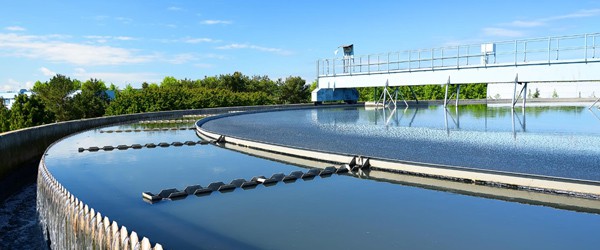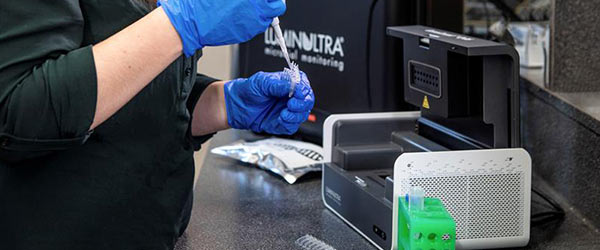The COVID-19 pandemic has amplified the need for communities to have reliable, timely methods of environmental monitoring for communicable disease.
In 2020, LuminUltra announced its patent for the first complete, rapid and on-site COVID-19 wastewater testing solution — an innovative new method to identify SARS-CoV-2 in wastewater.
But what is COVID-19 wastewater testing? How does it work? And who can benefit from its use? In this article, we’ll answer these questions and more about this vital early-warning system.
What is COVID-19 wastewater testing?
The COVID-19 virus is shed in human waste and creates a combined viral load in influent wastewater — water that flows from homes and offices to treatment plants and watersheds. Samples of this influent wastewater are tested for the presence of the SARS-CoV-2 pathogen. This enables public health to identify areas or communities with infections — even in asymptomatic or presymptomatic carriers — and mount an early response.
Since the virus was identified, scientists and engineers all over the world have been working hard to develop technology that can detect it quickly and reliably to limit community spread. Public health agencies use clinical testing to identify individual human carriers but broader methods can also be used to detect SARS-CoV-2 within a community or an environment.
One of these population-based methods is wastewater testing. While testing wastewater for pathogens is not a new concept, the COVID-19 pandemic has made it clear that wastewater testing is an invaluable tool in any fight against communicable disease.
Simply put, wastewater testing is a game-changer for early detection of SARS-CoV-2, the pathogen that causes COVID-19.
What are the benefits of COVID-19 wastewater testing?
Wastewater testing acts as a localized mass-screening method. It is a simple, cost-effective strategy that can identify COVID-19 cases through non-invasive measures. When compared with clinical testing, wastewater testing provides public health agencies with a full week of lead time for infection rate data. Because SARS-CoV-2 can be identified in the waste of asymptomatic or presymptomatic carriers, testing wastewater can zero in on community outbreaks that would potentially be identified much later with clinical testing alone.
Clinical testing, while an effective way of identifying individual cases of COVID-19, is only part of a complete community testing strategy. Wastewater testing is a powerful early-warning tool to inform further clinical testing, restrictions and other public health measures.
North America doesn’t currently have the capacity or resources to curb the spread of COVID-19 through clinical testing alone. The CDC tells us 40% of COVID-19 cases are likely asymptomatic, meaning there’s a good chance those individuals won’t seek, or qualify for (depending on location), a clinical test.
Learn more about the benefits in our webinar, COVID-19 Wastewater Testing: Why it matters, how it works and how to get started
How does wastewater testing work?
First, a sample is collected from a wastewater treatment plant or watershed. The sample is then combined with a lysis buffer and magnetic beads. Next, a magnet is applied to concentrate viral RNA (ribonucleic acid) on the beads. The sample is then washed and the RNA is eluted for analysis. Finally, the purified RNA is mixed with reagents and measured for SARS-CoV-2 in a GeneCount® qPCR device. Quantitative results are then reported as gene copies/mL.
Conventionally, testing wastewater for COVID-19 is a costly process that can take at least eight hours to return results. The testing methods require highly specialized training and equipment and typically offer a low viral recovery (10% to < 1%).
Drawing inspiration from magnetic bead extraction — a process wherein magnetic beads are used to extract and purify nucleic acids — LuminUltra has developed a cost-effective wastewater testing method that returns results in as little as 2.5 hours with a viral recovery of approximately 20%, making it more accurate than conventional methods. This is done with minimal equipment and doesn’t require highly-trained experts.
Watch this webinar for a more detailed explanation of LuminUltra’s wastewater testing method.
Who uses this data and how?
Broadly speaking, wastewater testing is used as a surveillance method to determine trends and spot outbreaks of COVID-19 in communities and inform public health responses like increased restrictions or clinical testing. The method has been used to detect SARS-CoV-2 in the Netherlands, US, Spain, Australia and Italy.
Although this method is still being explored as a solution in many places, it’s of particular interest to municipalities and institutions with vulnerable or densely distributed populations, like long-term care homes or college dormitories. Emerging use-cases like employee worksites, offices, airplanes and cruise ships may also be implemented soon.
Note: This process cannot determine the exact number of infected people or households in a community or identify infected individuals. Instead, it determines a community’s overall level of infection and offers the ability to monitor for trends and outbreaks. In other words, a community’s privacy is not impacted when wastewater testing is implemented.
Is wastewater testing for COVID-19 safe?
Yes, it is. Once the wastewater sample is combined with the lysis buffer, the virus is inactivated. Proper use of PPE (personal protective equipment), like masks, gloves, lab coats and face shields (all typical for wastewater testing), further reduces the risk of infection to virtually zero.
With proven capability to provide early warning of infection, COVID-19 wastewater testing is crucial to continuing to keep populations safe and to identify the presence of new variants.









